Take a Walk Through Okada-juku, Matsumoto’s Northern Post Town
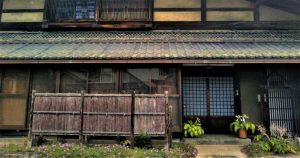
In a recent post we checked out Japan’s first toll road, part of the Zenkoji Kaido Route that allowed merchants, travelers, pilgrims and even nobility to more easily and quickly traverse the mountains between Matsumoto and Zenkoji Temple in the present-day city of Nagano.
We began at a quiet field called Tonya-hara, the place where, in 1605, a man named Tokoro began his career as the local transportation czar for this road. Fifty years later he moved his operation downhill, to the newly-established post town of Okada-juku. Today we’re going to check out what remains today of Okada – and what now only exists as a memorialized bit of dirt.
The De Facto Gateway to Okada
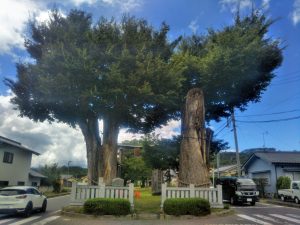
About three kilometers up the road from Matsumoto Castle you’ll find a big old wooden torii gate watching over a grassy median. Imposing in its own right, this torii is fronted by lanterns and memorials made of stone and, before them, two towering keyaki trees. It stands in the southernmost reaches of today’s Okada-machi neighborhood, and makes for the perfect starting point for our tour.
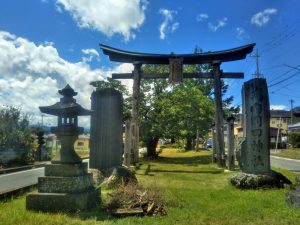
This massive torii marks the beginning of the sando prayer road that leads to 1,300-year-old Okada Shrine, about a ten-minute walk to the west. This sando was once lined with keyaki and pine, but has in recent decades fallen victim to the gods of progress and development. Even these two huge keyaki would have gone the way of the dodo but for the efforts of the people of Okada who valued them more than some extra pavement.
The Zenkoji Kaido & Okada-Juku Post Town
The Zenkoji Kaido (also known as the Hokkoku Kaido Nishiwaki-Ohkan and about four other names) connected the post town of Seba, near Shiojiri, on the famed Nakasendo Road and Shinanoi, up north, on the Hokkoku Kaido. This created a quick and handy route from the oft-used Nakasendo up through Matsumoto and over the mountains toward all-important Zenkoji Temple.
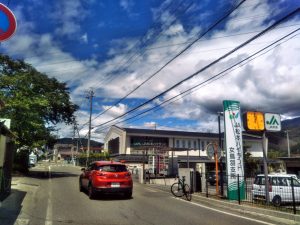
As with every road crawling across the land during the reign of the Tokugawa shogunate, the Zenkoji Kaido was dotted with post towns and checkpoints. Lying just north of the castle town of Matsumoto, Okada soon became a major stop along the Zenkoji route. Head north from the Okada Shrine torii, up this seemingly uninteresting street, and you’ll see remnants of Okada-Juku’s respectable past.
Protecting the People
About five hundred meters up the road and down a short side street, a modest grove of trees gives shade to a diminutive shrine with an impressive resume of godly relationships.
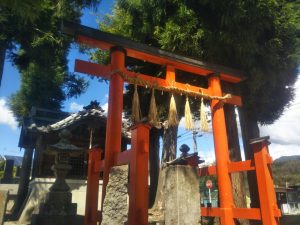
Shirayama Daigongen is related to Shirayama-Hime Jinja Grand Shrine in the old Kaga Domain in present-day Ishikawa Prefecture. As with the Grand shrine, this shrine houses Shirayama-Hime-O-kami, goddess of match-making and marital bliss, and the husband-wife deity duo of Izanagi and Izanami, the very creators of the islands of Japan. This shrine is also under the realm of Fushimi-Inari Shrine in Kyoto, as Ukanomitama, a deity associated with food and water, is also enshrined here.
As a route well-trodden by traders, pilgrims and travelers, the roadside is dotted with relics of spiritual protection. This Jizo-Bosatsu (above) was placed here not only for the safety of those passing by but for people to pray for those who had gone before and perished. Set in 1721, this jizo marks the site of the southern entrance to the former Okada-juku post town. Every spring, during the week of the vernal equinox, the locals carry on an age-old tradition of coming here to pray for good health and happiness.
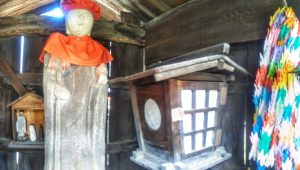
Here and there along the road you’ll also find dosojin – as you will everywhere you go in Shinshu. Dosojin are deities of sorts, usually represented by an elderly couple but sometimes consist of just a rock with 道祖神 engraved into the face. Placed along roads, at bridges and near the borders of their communities, they exist to protect travelers and the local residents in general. The dosojin here also serve as patrons of the well-being of children, happy marriage, safe pregnancy and childbirth, protection against outside evil entering the village, and a bunch of other things that wouldn’t fit on the signboard. As an aspect of folk religion, a dosojin having such a diverse set of personalities/talents is quite rare. No indication is given as to who gave these dosojin such a heavy workload.
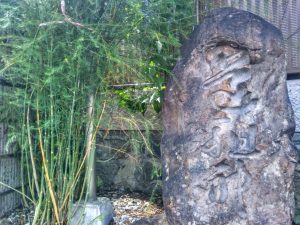
The Sankuro Festival, another local tradition, is also tied to the protective traditions of the dosijin. Held in three places within Okada-machi, Sankuro involves ringing in the new year by burning old objects of protection and carrying on with renewed hopes of health and prosperity, particularly for children.
People can also buy pieces of wood to burn in the Sankuro pyre for double-bonus extra good luck. After burning all their old things, children will receive new school supplies, and in the evening roast “mayudama” and “mochi”, balls of rice powder they roasted over the Sankuro fire earlier that day, eating them while sending prayers the dosojin’s way for good health and success in school.
Additionally, at New Year’s there is a special festival whereby people pass by this wooden dosojin shrine shouting “Celebrate!” 「祝っとくれ!」and tossing a few coins as an offering to the dosojin for health or good luck or pretty much whatever they want considering the versatility of the dosojin around here.
Where People Ran the Place
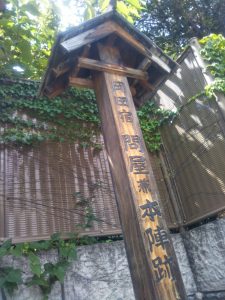
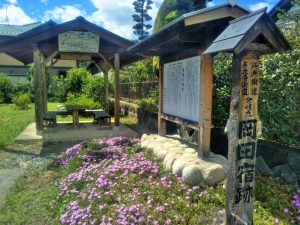
The wooden post up there marks the site where Tokoro-san, Okada-juku’s designated wholesaler and Grand Transportation Poobah centered his operations. Also in this immediate area is a small park which commemorates the places nearby where the Honjin and the Waki-Honjin used to stand. A Honjin was a high-end inn where nobles and officials with fancy titles would stay overnight. The Waki-Honjin was used when the Honjin was full.
Accommodations now are limited to this shaded picnic table which, modest as it is, provides some much needed escape from the hot sun during a walk through this mercilessly shadeless neightborhood.
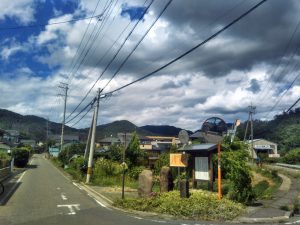
This fork in the paved road marks the spot where the north entrance to Okada-juku once stood. To the right lies the Hofukuji-do part of the Edo Kaido, which leads up the Metoba River and over Shinagura Pass. To the left runs the Zenkoji-do, past the Tonyahara, original site of Tokoro-san’s money-making endeavors, and the paths over the Umakai and Kariyahara Passes.
For a century or so Okada was just a post town, albeit a popular and growing one due to its proximity to Matsumoto. At its peak Okada-juku consisted of seventy households and their associated commercial ventures. It is also noted on the signboard here that a water duct ran down the middle of the village, shaded by trees on both sides, with places for people to tie their horses.
If there’s anything this place should have kept intact, it was that shaded waterway. And a place to park my bicycle.

Things changed for Okada-juku in 1725 when, in the final year of their reign as the Lords of Matsumoto, the Mizuno Clan rewrote some of the political lines in the area. The north-lying areas of Omi and Aida were taken away from the Matsumoto Domain and turned into shogunate territory. With this, Okada became the new border town between the shogunate territory and the Matsumoto domain. In 1726, the first year of the rule of the Toda clan, the regional Bansho was moved from Omi to Okada.
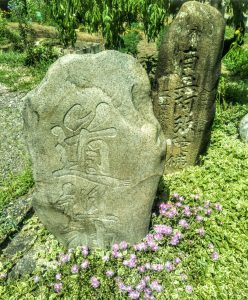
Bansho, which were located at important and strategic spots across the entire network of Edo Era roads, were stations where officials monitored the movement of women, lumber, hemp, rice, salt, and horses, among other things. The Okada Bansho was located here, at the north entrance to the village, and was marked by a square “masugata” gateway, designed much like the Kuro-mon and Taiko-mon gateways of Matsumoto castle. Such an entrance served a defensive purpose in case of an attack while preventing outsiders from seeing into the interior of the town.
With the beginning of the Meiji Era and the end of Japan’s feudal period, Okada saw its story as a bansho and important Edo post town come to an end. But Okada-machi remains as a regular, everyday Japanese neighborhood – with its history still intact.
What Remains to be Seen
While the utilitarian, form-follows-function style of living permeates this neighborhood, as it does most of the rest of modern Japan, there are still signs of a time where people still did things in that alluring traditional way. Look for them as you make your way up through Okada-machi. Imagine that waterway running down the middle of the road. But remember to bring your own water.
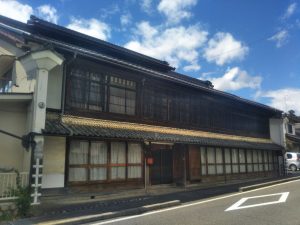
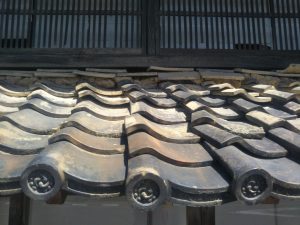
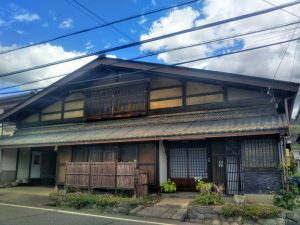
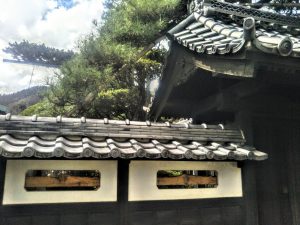
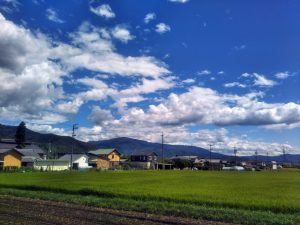
And finally, the Okada Shrine torii and the beginning of your walk through Okada: